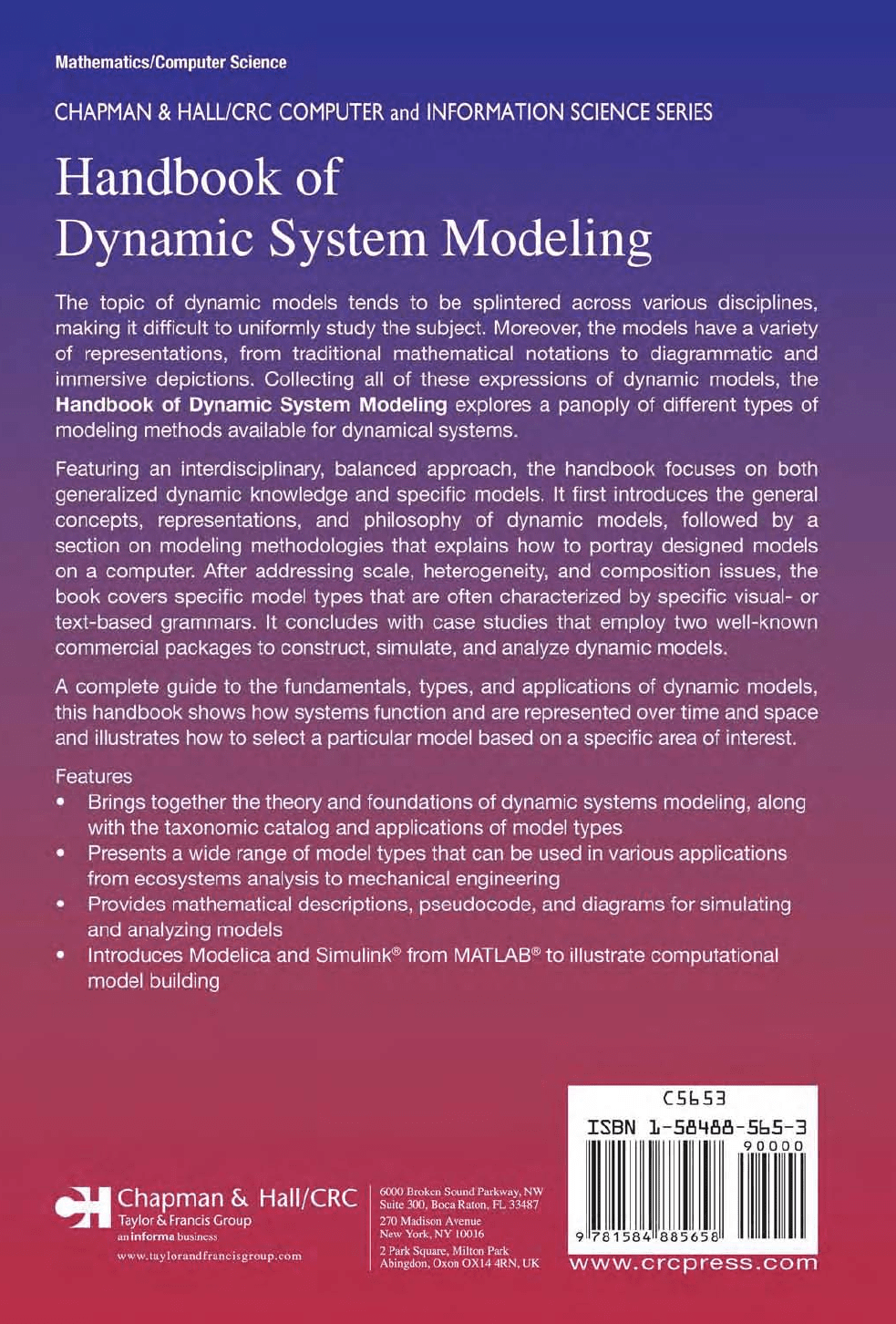Fishwick P.A. (editor) Handbook of Dynamic System Modeling
Подождите немного. Документ загружается.

I-8 Index
Mathematical modeling (Contd.)
time-based classification, 3-7 to 3-8:
continuous-time models, 3-7;
discrete-event models, 3-7 to 3-8;
discrete-time models, 3-8; static models,
3-8
Mathematical optimization programs,
in ERGs, 23-13 to 23-16
MATLAB
®
, 37-2
Maxwell symmetry, 26-25
mean value analysis (MVA), 25-16 to 25-17
Meaning, 1-8
connotation concept, 1-8
defining, possibilities for, 1-8
denotation concept, 1-8
Membrane elements, 13-9 to 13-12
2-D shape functions, 13-9 to 13-10
flat plate and shell elements, 13-12 to 13-15
generalized stress, 13-14 to 13-15
Kirchoff theory, 13-13
Mindlin theory, 13-13 to 13-14
plate theory, 13-13 to 13-14
mesh correctness and convergence, 13-11
stress difference to indicate mesh accuracy, 13-11
element meshing, 13-11 to 13-12
membrane theory, 13
-9
shear locking, 13-10 to 13-11
Mesh-based simulation
classification, 12-8
reverse classification, 12-8
Military modeling, 32-1 to 32-13
applications, 32-1 to 32-2
dynamics, 32-4 to 32-8
dynamic environment, 32-8
engagement, 32-7
exchange, 32-6 to 32-7
movement, 32-5
perception, 32-5 to 32-6
reasoning, 32-7 to 32-8
military simulation systems, 32-11 to 32-12
modeling approach, 32-8 to 32-11
artificial intelligence, 32-10 to 32-11
logical process, 32-10
Mathematic, 32-9 to 32-10
Physics, 32-8 to 32-9
stochastic processes, 32-10
representation, 32-2 to 32-4
constructive model, 32-3
engineering, 32-2 to 32-3
environment, 32-4
live, 32
-4
virtual model, 32-3
Mindlin theory, 13-13 to 13-14
Modal methods, 13-19
Model execution, See under Execution, model
Modelica, multidomain modeling with, 36-1 to 36-25
basics, 36-3 to 36-17
component coupling, 36-6 to 36-10
connector definitions in, 36-9
discontinuous systems, 36-10 to 36-13
Modelica libraries, 36-17 to 36-19
automatically constructed parameter dialog,
36-18
overview, 36-1
relation-triggered events, 36-13 to 36-14
symbolic processing of, 36-19 to 36-25
index reduction, 36-21 to 36-22
size and complexity, reduction of, 36-20 to
36-21
sorting and algebraic loops, 36-20
variable structure systems, 36-14 to 36-17
vehicle components modeled in, 36-2
Molecular dynamics, 12-5 to 12-6
Multimodeling, 14-1 to 14-27
boiling water example, 14-20 to 14-26, See also
under Boiling water
dynamic exchange language (DXL), 14-13 to
14-20, See also separate entry
integrative multimodeling, 14-2 to 14-4, See also
separate entry
multimodeling exchange language (MXL), 14-11
to 14-13, See also separate entry
RUBE framework, 14-4 to 14-5 scene
construction, 14-5 to 14-11
blender interface, 14-10 to 14-11
interaction model creation, 14-8 to 14-10
ontology, 14-5 to 14-8: classes and relationships,
14-6 to 14-8; for the boiling water, 14-7;
properties and relationships, 14-8
Multimodeling exchange language (MXL), 14-11 to
14-13
concepts, 14-11 to 14-12
multimodeling in, 14-12 to 14-13
Multiple degree of freedom (MDOF) dynamic
analysis, 13-19 to 13-21
normal mode shapes for, 13-20
Multiport generalizations, 26-21 to 26-28
coenergy and Legendre transforms, 26-22 to
22-25, See also under Legendre transforms
loudspeaker example, 26-25 to 26-28
Multiscale simulation, multimodel hierarchy for,
12-1 to 12-16
composite material system, design, 12-2
for drug delivery system,
12-3
functional and information hierarchies in, 12-4 to
12-10
domain definitions, transformations, and
interactions, 12-7 to 12-9, See also under
Domains

Index I-9
mathematical Physics description
transformations and interactions, 12-4 to
12-7: molecular dynamics (MD), 12-5 to
12-6; partial differential equations (PDE),
12-4 to 12-5; PDEs and MD, interactions
between, 12-6 to 12-7
physical parameter definitions, transformations,
and interactions, 12-9 to 12-10
functional components to support, 12-10 to 12-14
equation parameters, 12-12 to 12-13
interactions between components, 12-11
problem definition, 12-12
scale-linking operators, 12-14
tensor fields, 12-13 to 12-14
multimodel simulation procedures, 12-14 to 12-15
adaptive atomistic/continuum adaptive
multiscale simulation, 12-15
automated adaptive mesh-based simulation,
12-14 to 12-15
quasicontinuum method in, 12-3
N
Navier–Stokes equations, 21-12
Network traffic, 15-4
O
Object Model Template (OMT), 9-3
tables, 9-4
Odum’s systems philosophy and methodology, 28-2
Ontology
for modeling and simulation, 3-12
for scientific domains, 3-11
Open queueing networks, 25-13 to 25-15
Open Source Physics library (OSP), 17-3
Ordinary differential equations, 17-1 to 17-20
adaptive step, 17-11 to 17-12
adapting the step, 17-11 to 17-12
embedded Runge–Kutta formulas, 17-11
implementation, 17-12 to 17-15: interpolation,
17-15; multistepping, 17-15
interval-halving, 17-11
chemical reactions, dynamics of, 17-2
implementation techniques, 17-5, 17-8 to 17-11,
See also Runge–Kutta methods; Taylor
methods
numerical solution, 17-3 to 17-5
OSP library, 17-20
performance and other methods, 17-15 to 17-19
extrapolation methods, 17-17 to 17-18
implicit algorithms and stiff equations, 17-16 to
17-17
multistep methods, 17-17
symplectic integration methods, 17-18 to 17-19
planetary motion, 17-2 to
17-3
predator–prey population dynamics, 17-2
simple pendulum, 17-1
state events, 17-19 to 17-20
P
PackageModelica, 36-17
Parallel simulation, 10-2
Parametric event relationship graphs, 23-7
to 23-8
Partial differential equations, 12-4 to 12-5
Pending events list, 23-3
Pendulum model, 37-5
Persistent oscillations and chaos, 18-13 to 18-14
Petri nets
analysis of, 24-7 to 24-10
incidence matrix and state equation, 24-8
invariant analysis, 24-8 to 24-10:
minimal-support invariant, 24-9; support
of an invariant, 24-9
reachability analysis, 24-7
simulation, 24-10
colored Petri nets (CPNs), 24-10 to 24-12
definition, 24-1
for dynamic event-driven system modeling, 24-1
to 24-16
modeling power, 24-4 to 24-5: concurrency,
24-4; conflict, 24-4; mutually exclusive,
24-4; priorities, 24-4; resource constraint,
24-4; sequential execution, 24-4;
synchronization, 24-4
transition firing, 24-3 to 24-4, See also separate
entry
mapping, into ERGs, 23-11 to 23-13
marking in,
24-2
Petri net modeling language, 7-6 to 7-11
constraint, 7-8
defining the modeling language, 7-7 to 7-8
dining philosophers in, 7-8 to 7-9
Petri net language, dining philosophers in, 7-8
to 7-9
places, 1-8
properties, 24-5 to 24-7
liveness, 24-6 to 24-7
reachability, 24-6
safeness, 24-6
timed Petri nets, 24-12 to 12-16, See also under
Petri nets
tokens, 1-8
‘PhysicalEntity’ 3-13
Ping-pong protocol, DEVS modeling, 6-2, 6-5
to 6-7
Planetary motion, 17-2 to 17-3
Plate theory, 13-13 to 13-14
Poisson arrival process, 25-9

I-10 Index
Port-based modeling
bond graphs, 26-5 to 26-21, See also separate entry
dynamic models, 26-3 to 26-4
multiport generalizations, 26-21 to 26-28, See also
separate entry
of engineering systems in terms of bond graphs,
26-1 to 26-28
power conjugation, 26-4
structured systems, physical components and
interaction, 26-4 to 26-5
dynamic conjugation, 26-4
versus traditional modeling, 26-1 to 26-3
Pragmatics, 1-4 to 1-5, 1-10 affecting modeling, 1-10
Predator–prey population dynamics, 17-2
Process algebra, 19-1 to 19-20
algebraic reasoning and verification, 19-11 to
19-19, See also separate entry
calculation, 19-2
definition, 19-1 to 19-2
history, 19-3
hybrid process algebra, 19-3
χ process algebra, 19-4 to 19-11, See also separate
entry
χ Process algebra
syntax and informal semantics of, 19-4 to 19-11
assembly line example, 19-6 to 19-7: iconic
model of, 19-6
atomic statements, semantics of, 19-9 to 19-10:
skip and multiassignment, 19-9; delay
predicate, 19-9; delay statement, 19-10
compound statements, semantics of, 19-10 to
19-11: alternative composition, 19-11;
guard operator, 19-10; loop and while
statement, 19-11; parallelism, 19-11;
sequential composition, 19-10; variable
and channel scope operator, 19-11
controlled tank, 19-4 to 19-6: simulation of,
19-4
semantic framework, 19-8 to 19-9
statement syntax, 19-7 to 19-8
Propositional logic, 20-1 to 20-3
Q
Queueing system models, 25-1 to 25-18
Little’s Law, 25-7 to 25-8
non-Markovian queueing systems, 25-17 to 25-18
performance of, 25-4 to 25-6
queueing system dynamics, 25-6 to 25-7
simple Markovian queueing models, 25-8 to 25-11,
See also under Markovian Queueing models
specification of, 25-2 to 25-4
issues to consider, 25-3
notation, 25-3
operating policies, 25-3
stochastic models, 25-2
structural parameters, 25-3
R
Rapid prototyping, 37-17 to 37-18
Rational equations, 5-3 to 5-4
Reactive systems, 19-2
Recursion scope operator, 19-14
Reflexivity, 20-7
Relation
set-theoretic concepts, 1-9
Representation-building
in analogy-making, dynamics of, 2-5 to 2-6
Robotic arm model, 37-7 to 37-12
computational model of, 37-7
CAD model of, 37-8
electromechanical model of the motor and
coupling, 37-8 to 37-9
generating the motor models from data, 37-11
to 37-12
mechanical model of arm, 37-8
tuning the motor parameters with data, 37-9 to
37-11
RUBE framework, 14-4 to 14-5
Runge–Kutta methods, 17-7 to 17-8, 17-10 to 17-18
embedded Runge–Kutta formulas, 17-11
generic Runge–Kutta table of coefficients, 17-7
Runtime Infrastructure (RTI), 9-3
services, 9-4
S
Scaling up issue, 2-16
Semantic Web impact, on modeling and simulation,
3-1 to 3-20
adding semantics to simulation models, 3-10 to
3-12
ontology for modeling and simulation, 3-12
ontology for scientific domains, 3-11
causality-based classification, 3-9
classification based on determinism, 3-9
discrete-event simulation (DeSO), conceptual
basis for, 3-4 to 3-6
entity, 3-4
event, 3-4
force case, 3-6
force, 3-5
no force case, 3-6
space, 3-4
state, 3-5
time, 3-4
mathematical models, types of, 3-6 to 3-9, See also
under Mathematical models
relevant issues, 3-2 to 3-4
semantic Web languages, 3-4
Index I-11
Semantic Web rule language (SWRL), 3-3
Semantics, 1-4 to 1-5, 1-7 to 1-10
functional semantic mappings, 1-7
in temporal logic, 20-5 to 20-6
meaning in, 1-8, See also under Meaning
semantic Web, 1-10
Semiconjugacy, 18-14 to 18-17
Semiotics, 1-4
Sensor network component-based simulator, 35-1 to
35-16
component-oriented simulation toolkit (COST),
35-3 to 35-7, See also separate entry
currently available components and simulation
engines, 35-2 to 35-3
need for, 35-1 to 35-3
SENSE, features of, 35-2
wireless sensor network simulation, 35-7 to 35-15,
See also separate entry
Sequential simulation, 10-2
Shrinking gradients problem, 22-8
Sign
formation, triangular relationship in, 1-4
Simple pendulum, 17-1
Simulation interconnection, theory and practice for,
16-1 to 16-9
composition issue, 16-2
configuration issue, 16-2
integration issue, 16-2
interoperation issue, 16-2
simulation composability,
16-6 to 16-9
composability and complexity, 16-6 to 16-7:
composability, formalisms for, 16-8;
composability, restricting the scope of,
16-8 to 16-9
history of, 16-6
simulation interoperability, 16-2 to 16-5
aggregate level simulation protocol, 16-4 to 16-5
distributed interactive simulation, 16-4
entity-level simulation, 16-4
high level architecture, 16-5
simulator networking, 16-3
Simulation models
adding semantics to, 3-10 to 3-12
Simulink
®
models for model-based design,
simulation, 37-1 to 37-19
case study, 37-3 to 37-4
computational models for control design, 37-12 to
37-16
designing a controller, 37-14 to 37-16
designing controllers through modeling and
simulation, 37-12 to 37-13
linearizing models for control system design,
37-13 to 37-14
optimization technique, 37-16
SISO design plots, 37-15
computational models, obtaining, 37-4 to 37-7
modeling from first principles, 37-5 to 37-7
using data and simulation to obtain or tune
models, 37-7
designing with simulation, 37-4
model-based design, testing with, 37-16
to 37-19
rapid prototyping control design process, 37-17
to 37-18
requirements-based testing through simulation,
37-17
simulation with hardware and implemented
designs, 37-17 to 37-18
pendulum model, 37-5
robotic arm model, 37-7 to 37-12, See also separate
entry
robotic arm, 37-2
SimMechanics models, 37-6
Single degree of freedom (SDOF) dynamic analysis,
13-17 to 13-19
S-invariant concept, 24-8
‘Slipnet,’ a semantic network, 2-8 to 2-9
Spatio-temporal connectionist networks (SCNs),
22-1 to 22-9
applications, 22-8 to 22-9
basic approach, 22-4 to 22-5
connectionist networks (CNs), 22-2 to 22-4, See
also separate entry
learning, 22-6 to 22-8
mathematical and numerical modeling approaches
to, 21-1
popular SCNs, 22-5
Elman network, 22-5
Giles et al network, 22-5
Williams and Zipser network, 22-5
representational power, 22-6
unfolding an, 22
-7
Static models, 3-8
Stella diagram, 27-2
Stochastic models, 25-2
Stochastic timed Petri net (STPN), 23-10 to 23-11
Stokes–Dirac structure, 26-14
Symbols, in energy systems language
categories, 28-6
circles, 28-6
composite symbols, 28-6
price-controlled flow symbol, 28-7
rectangle, 28-7
storage symbol, 28-6
two-way interaction symbol, 28-7
within the system boundary, 28-6 to 28-7
Symplectic gyrator (SGY), 26-12
Symplectic integration methods, 17-18 to 17-19
Synchronous input property, 14-16
Synchronous languages, 36-10

I-12 Index
Syntax, 1-4 to 1-7
in temporal logic, 20-5 to 20-6
same state machine, interpretation, 1-6
BrettBaskovich, 1-6
Christina Sirois, 1-6
EmilyWelles, 1-6
TimWinfree, 1-6
Systems engineering, 4-1 to 4-9
definition, 4-6
levels for, 4-2
life cycles, 4-3, 4-5
phases, 4-5
process-oriented view of, 4-5
systems engineering life cycles (SELC), 4-7
analysis and assessment of the alternatives, 4-7
formulation of the issue, 4-7
interpretation and selection, 4-7
technical direction and systems management,
importance, 4-4 to 4-8
inactive, 4-4
interactive, 4-4
proactive, 4-4
reactive, 4-4
T
Tabletop program, 2-12 to 2-13
semantic memory used in, 2-14
Taylor methods, 17-4, 17-5 to 17-6
Temporal logic, 20-1 to 20-14
introducing, 20-3 to 20-5
models of time, 20-6 to 20-10
boundedness, 20-9
combinations of properties, 20-10
density and discreteness, 20-9 to 20-10
irreflexivity, 20-7 to 20-8
linearity, 20-8 to 20-9
reflexivity, 20-7
transitivity, 20-7
propositional logic, 20-1 to 20-3
syntax and semantics, 20-5 to 20-6
Timed Petri nets, 24-12 to 12-16
deterministictimed Petri nets (DTPNs), 24-12,
24-13 to 24-14
stochastic timed Petri nets (STPNs), 24-12, 24-14
to 24-16
topological structure of, 24-12
Time-stepped simulation method, 10-2
T-invariant concept, 24-8
Traffic flow model, 34-17 to 34-18
Transformity principle
of diagram layout, 28-5
overall effect of transformity on, 28-6
sources arrangement, 28-5 to 28-6
Transition firing, 24-3 to 24-4
enabling rule, 24-3
firing rule, 24-3
self-loop transition, 24-3
sink transition, 24-3
source transition, 24-3
Transitivity, 20-7
Two-point integration schemes, 11-19 to 11-21
V
Validation process, 1-2
Vensim diagram, 27-2 to 27-4
Verbal event graphs, 23-6
Verification process, 1-2
W
Web Ontology Language (OWL), 30-1
Williams and Zipser network, 22-5
Wireless sensor network simulation, 35-7 to 35-15
running the simulation, 35-14 to 35-15
Z
Zero-crossing detection, 15-17 to 15-18

